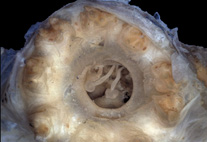Abstract
Most species of Taeniogyrus Semper, 1867 are known from shallow water in the Indo-Pacific, with other records in Antarctica, Mediterranean Sea, and the Atlantic. A new species of Taeniogyrus is described and illustrated here from the continental slope of Campos Basin, southeast of Brazil. In this species, sigmoid hooks (336–405 µm) are much larger than in any other in the genus, bearing a long and conspicuous hook region. Wheels with six spokes (86–169 µm), inner margin with 60–125 continuous teeth, are confined to round papillae along each interradius. Polian vesicles are ventral, numerous (15–21), of different sizes, and tubular shaped with a terminal round region. This new species represents the deepest record of the genus Taeniogyrus. It increases to three the number of chiridotids in Brazilian waters, and the number of Taeniogyrus species in the Atlantic. Additionally, Taeniogyrus furcipraeditus (Salvini-Plawen, 1972) from the Mediterranean Sea and Taeniogyrus havelockensis (Rao, 1975) from the Andaman Sea are proposed as new combinations.

